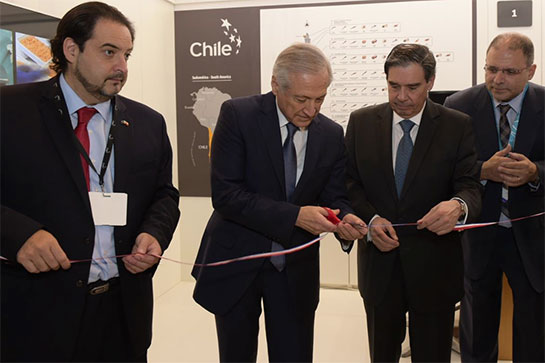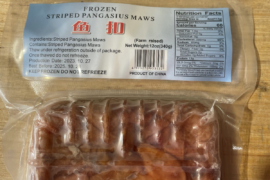“Europe is a market of vital importance for the Chilean fishing and fish farming industry,” stated Heraldo Muñoz, Chile’s Minister of Foreign Affairs, as he opened the ProChile pavilion at Seafood Expo Global in Brussels on April 21. He was accompanied by Carlos Appelgren Balbontin, the Chilean Ambassador in Belgium, and Andrés Rebolledo, General Director of International Economic Relations at the Ministry of Foreign Affairs.
“Overseas buyers of Chilean food appreciate the economic and political stability of Chile, which incentivizes entrepreneurship. They also recognize that modern infrastructure and export logistics, state-of-the-art technology used in production and processing, rigorous compliance with international standards and certifications, and an extensive network of free trade agreements all help to make our country a reliable supplier of high quality, safe food,” said Muñoz.
Chile boasts an extensive coastline, clean waters and a natural abundance of fish in the sea, as well as an established aquaculture sector. The nation’s geographic location in the South Pacific, together with the phytoplankton-rich Humboldt Current, converge to provide a hospitable habitat for a vast range of fish and shellfish that may be sustainably harvested.
This rich resource is targeted by an increasingly professionalized industry, which is building successfully on the traditions of more than 90,000 fishermen who carry out small-scale fishing activities.
The enforcement of regulations designed to improve sustainability is of vital importance for the future development of the Chilean seafood industry. This includes fishing quotas, global Total Allowable Catches (TACs), fishing bans, and closed seasons during fish reproduction periods. The contribution of R&D to fishing and aquaculture has led to production growth, and diversification of resources.
 Chilean Minister of Foreign Affairs Heraldo Muñoz (second from left) cuts the ribbon to open the ProChile pavilion at Seafood Expo Global in Brussels.
Chilean Minister of Foreign Affairs Heraldo Muñoz (second from left) cuts the ribbon to open the ProChile pavilion at Seafood Expo Global in Brussels.
The innovative processing industry benefits from a highly trained workforce and competitive labor costs, which makes Chile an attractive supplier for European seafood buyers. Leading products are Atlantic and Pacific salmon, rainbow trout, seaweed, mussels, jack mackerel, hake, cuttlefish, fishmeal and fish oil.
Chile is the world’s largest exporter of trout, Pacific salmon and mussels, and the second biggest supplier of Atlantic salmon. Salmon and trout account for 55% of the nation’s seafood shipments to Europe, with mussels weighing in at 12% and fish oil representing 8%.
In 2014, total shipments of Chilean seafood generated US $6.16 billion in revenues, an increase of 17% compared to 2013’s exports of $5.28 billion. Japan, the United States and Brazil were the main markets. Seafood exports to Europe amounted to $1.17 billion (+17% compared to 2013), making up 19% of total Chilean sales of Chilean fishery products abroad. Exports to Russia increased by 32%, while sales within the European Union earned $721 million in receipts. Exports to Germany increased by 24%, making it the second largest importer of Chilean seafood in Europe after Spain – and just ahead of France.
Exports of salmon and trout to Europe accounted for 15% of total sales of these products, and increased from $539 million in 2013 to $647 million in 2014 (+20%).
Europe is by far the main export destination for Chilean mussels, with 71% of total shipments and a value of $135 million in 2014, making it comparable with 2013. Exports of fish oil to Europe more than doubled last year, reaching a value of $89 million and accounting for 56% of total Chilean fish oil exports.
Expecting that European demand for Chilean seafood will increase in the next few years, General Director Rebolledo commented: “Chile’s innovative seafood industry supplies high quality, safe products produced under excellent environmental and sanitary conditions. Our processors have adapted their offering to take account of the growing demand for healthy products and convenience foods, incorporating formats such as portioned, boneless, fat-free and nutritious options, along with products of higher added-value.”





